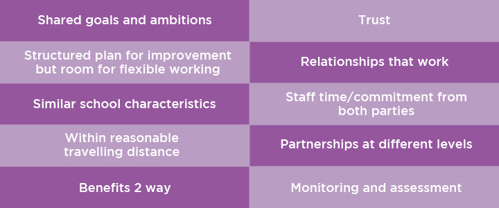School improvement: moving beyond Covid to a stronger education system
Wednesday 18 November 2020
 Today, the NAHT published the findings from its School Improvement Commission. The report draws together research evidence and testimony from a number of expert witnesses and organisations, including the NFER.
Today, the NAHT published the findings from its School Improvement Commission. The report draws together research evidence and testimony from a number of expert witnesses and organisations, including the NFER.
Schools have had to provide a safe environment for both staff and pupils, while teaching and learning is disrupted to a level never seen before. The report makes it clear that sustainable school improvement is an ongoing, long-term activity.
The Covid-19 pandemic has meant that the school improvement challenge has arguably never been greater. It has required schools to deal with the immediate challenges of providing a safe environment for both staff and pupils. It has also severely disrupted teaching and learning processes, as we have written about extensively elsewhere. In the medium-term, this will require a focus on learning recovery and catch-up, but as the commission’s report makes clear, sustainable school improvement is an ongoing, long-term activity that all schools should engage in, and it is likely to require a multi-faceted approach involving a range of stakeholders.
The report highlights a number of salient messages and actions, many of which accord with our own research evidence, as discussed below.
- Schools are only as good as the people that work in them. Teacher quality is the driving force of school improvement, so if we want every pupil in the country to be taught by an expert teacher, we need schools to have access to high-quality CPD for all teachers, as well as a ready supply of expert staff. In addition to ensuring teachers have the time and freedom to engage in professional development, we need to reduce unnecessary workload wherever possible. School leaders are increasingly doing more to reduce teachers’ working hours. In addition, there is some evidence to suggest that teachers’ working hours have reduced in recent years, and that prior to the pandemic, teachers’ perceptions of their workload may also have been improving. Recent months have also seen a surge in applications for initial teacher training – an encouraging sign for schools’ short-term supply needs – but we need to ensure these new teachers stay in the profession.
- School leaders need to create the conditions in which teachers can flourish and pupils can succeed. This risks becoming lost as additional responsibilities are loaded onto the role, and accountability pressures drive activity that has more to do with being Ofsted-ready than improving teaching and learning. Our own research suggests that headteachers are more likely to focus on external challenges, such as deprivation, austerity, and staff supply, rather than those elements they can control, like improving the quality of teaching within school. Headteachers should be empowered to reassert their role as leaders of learning in the face of pressure for quick wins or shifting goalposts. And, they need support and training in order to do so.
- School improvement should be a collaborative endeavour. There are real benefits to working in partnership with others, but the current system too often places schools in competition instead. For example, there is considerable evidence that school-to-school partnership working can be effective in supporting and accelerating improvements in participating schools, particularly where schools exhibit certain characteristics, such as shared goals and ambitions for development. We need to re-examine incentives and structures within the system to redress this imbalance.
Ten characteristics of an effective school-to-school partnership

Source: NFER evaluation of the Gaining Ground Strategy
A range of delivery mechanisms exist to support collaborative working, including the recently announced time-limited school-to-school recovery support to schools and trusts to overcome challenges faced or exacerbated as a result of the pandemic. However, our research with schools in challenging circumstances also revealed that some headteachers experience ‘initiative overload’, and can become overwhelmed by the range of support initiatives available. It is important that schools are able to diagnose and prioritise their improvement efforts, drawing on fresh insights and support from others.
- School improvement should be seen as a continuous journey, not a destination to be arrived at. Too often, schools mark their improvement through the Ofsted grading lens. Indeed, fixating on Ofsted can lead to a short-term focus, and a ‘scatter-gun’ approach to improvement, with a range of initiatives launched with limited assessment of what actually works. NFER’s research, in support of the commission’s work, explored senior leaders’ and classroom teachers’ views on the effectiveness with which schools identify, prioritise and take action on school improvement priorities. Our analysis found that appropriate action did not always follow identifying school priorities as school staff were forced to respond to more immediate issues.
Final thoughts
In order to achieve the goals outlined above, we must move towards long-term, sustainable, improvement over quick fixes. We must also acknowledge that schools alone cannot tackle the wider societal challenges of poverty, unemployment and poor housing.
School leaders already have much of the power to change the climate, but they must be supported and developed to create the conditions for their teachers and students to thrive. Too many feel forced to compete with their peers in the face of high-stakes accountability measures, pushed into short-term patches rather than long-term improvement. Now it just needs to be easier to choose the right path, to align accountability measures and incentives, and help make our schools the best places possible to work and to thrive.
